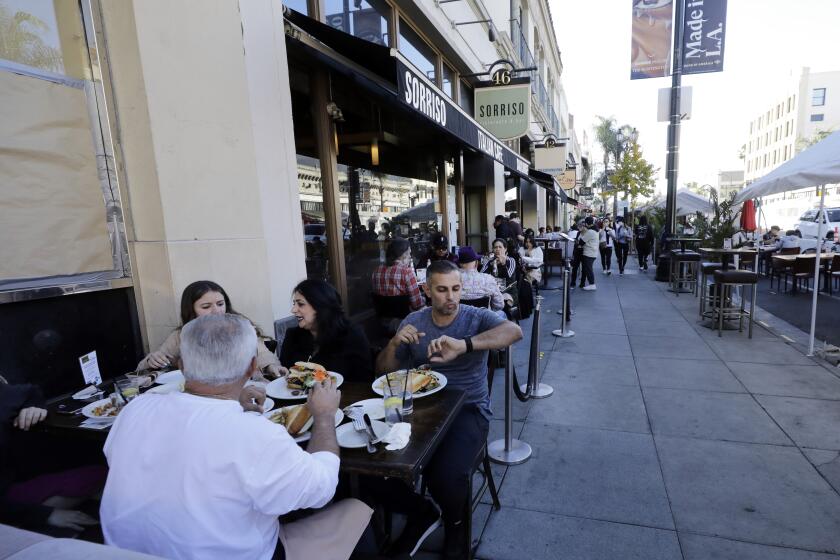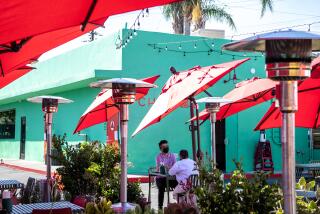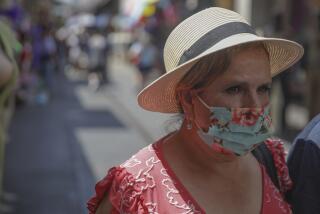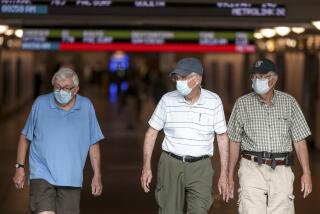Guy Fieri and many others hate outdoor restaurant ban. Here’s why some experts say it’s essential
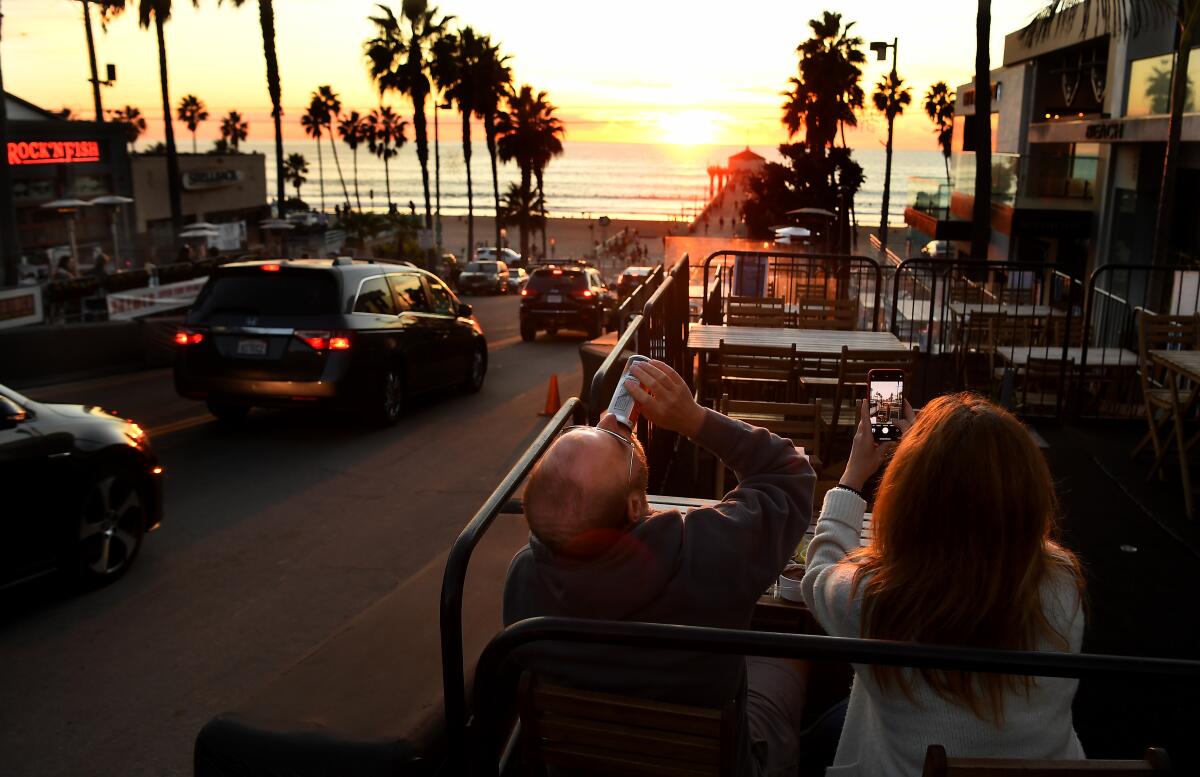
- Share via
The controversial ban on outdoor restaurant dining, part of an effort to break the back of California’s coronavirus surge, has clearly touched a nerve.
Lawsuits have been filed seeking to overturn it in Los Angeles County. Celebrity chef Guy Fieri urged an end to the ban, tweeting, “We gotta keep Flavortown open for biz!”
An L.A. County judge issued a rebuke of how the county issued its order.
Restaurants have argued that public health officials have not provided evidence that outdoor dining spreads COVID-19 significantly and that they have taken precautions to make eating outdoors safe. They say they are being treated unfairly, especially considering that shopping malls remain open as well as many indoor businesses.
Even top federal health officials have dueling points of view. The assistant secretary for health in the U.S. Department of Health and Human Services, Adm. Brett Giroir, said on Fox News that “I don’t know of any data that says you need to shut down outdoor dining.”
L.A. County Superior Court Judge James Chalfant said county public health officials must conduct a risk-benefit analysis if they want to extend the ban.
The L.A. and Beverly Hills city councils have passed resolutions opposing the ban and asking the county Board of Supervisors to reconsider.
Defending the order
Meanwhile, Dr. Anthony Fauci, the nation’s top infectious disease expert, on CNN backed the broad outlines of the stay-at-home order in effect for 36 million Californians, which includes the ban on outdoor dining.
“I have been in discussion with the health authorities from the state of California who called me and asked, you know, they said, ‘We feel we need to do this, what do you think?’ And I said, ‘You know, you really don’t have any choice.’ When you have the challenge to the healthcare system, you’ve got to do something like that,” Fauci said.
The L.A. County director of public health, Barbara Ferrer, was asked to respond to Giroir’s comments Monday at a news conference.
“The data is really crystal clear at every single level that you look at it: That wearing a mask is one of the best protections you have from preventing [coronavirus infections],” Ferrer said. “I don’t think there’s any debate: That where people are in close proximity with other people, not in their household, not wearing masks and mingling for extended periods of time ... there’s increased risk of transmission.”
And while everyone agrees that the chance of indoor virus transmission is higher than outdoors, Ferrer said, “I don’t think anybody would say that there’s no risk of transmission just because you’re outside.”
There are a number of examples of coronavirus outbreaks where people weren’t wearing masks, including the super-spreader event at the White House Rose Garden ceremony introducing President Trump’s nominee to the Supreme Court in September, Ferrer said.
The debate has been complicated by local officials who allowed outdoor restaurant dining to continue for months, Ferrer said, when it seemed relatively safer to do so even as indoor restaurant dining was closed again in much of California when the summer wave of the coronavirus hit.
When Gov. Gavin Newsom suspended indoor restaurant dining for a second time in mid-July in the hardest-hit counties, he allowed outdoor dining to continue.
“I think that’s what’s hard on people ... a few weeks ago, we said, ‘Outdoor dining was fine.’ And now, a few weeks later, we’re saying, ‘Not so fine. And please don’t do it,’” Ferrer said. “And the reason is that [now] the risk is just that much greater.”
L.A. restaurant owners are sharing their frustration over the shutdown of in-person dining.
To be specific, two months ago, only about 1 in 880 L.A. County residents were estimated to be contagious with the coronavirus. Today, that ratio is about 1 in 145 people, according to calculations by the L.A. County Department of Health Services.
Some researchers at the Keck School of Medicine at USC estimate it’s actually even worse, and that about one in 50 are contagious with the virus in L.A. County, said Dr. Paul Simon, chief science officer for the Department of Public Health.
“Now, the rate of infectivity is so much higher. And, in fact, we’re now threatening to overwhelm our healthcare system,” Ferrer said. “You have to look at all of the activities and say, ‘We need to reduce risk as much as possible everywhere.’ And that’s why the decision was made, for three weeks, to ask that everyone not go to any outdoor dining — any dining at all — with people not in their household.”
Changing conditions
Dr. Mark Ghaly, California’s Health and Human Services secretary, made the same point Tuesday, saying “it’s quite a different situation” when you have the kind of widespread community transmission the state is seeing now, and that some activities that may have been considered safe a month ago “aren’t as low-risk as they used to be.”
Higher-risk activities, he said, are generally those where people are congregating with or near those they don’t live with for extended periods of time without consistently wearing face coverings.
“Right now, we’re seeing such high levels of transmission that almost every activity, I should say every activity, that could be done differently and keep us at our home, not mixing with others, is safer,” he said. “Those are going to be the tools that help us get this under control.”
Dr. Robert Kim-Farley, an epidemiologist and infectious disease expert at the UCLA Fielding School of Public Health, likened the change in risk to how you might worry about getting uncomfortably soaked when there’s a chance of rain while dining outside.
When fewer people were contagious, the risk could be compared to the relatively minimal possibility of getting wet when there’s only a light sprinkle. But now, with possibly around 1 in 100 people in L.A. County contagious, that makes dining outside, and doing other activities that interact with other people, far riskier.
“If it’s a downpour — because the whole community has widespread transmission — if you’re going to be outside, you’re going to get wet. You could get the virus,” Kim-Farley said.
The dueling viewpoints may lead some to believe that public health experts have no idea how to control COVID-19, and that would be a wrong conclusion, Kim-Farley said.
Drastic measures
Yes, there may be quibbles over whether certain outdoor activities are worth banning. But the larger idea — that the coronavirus is spread when people interact in close proximity to one another — is irrefutable, Kim-Farley said.
The recent experience with California’s third surge shows how a nuanced approach did not avert the worst of the first two surges of the pandemic.
It was in early October when state officials unveiled policies that allowed small outdoor gatherings to resume, moves that came weeks before the latest surge. Gatherings for holidays like Halloween and Thanksgiving also played a role in worsening transmission.
Outdoor dining venues are risky because people aren’t wearing their masks when eating or drinking. And some venues may be more risky if owners have surrounded the seating area with plastic sheets to protect diners from the elements — including breezes that could dispel the virus from hanging in stagnant air. If the air is still, there’s an increased risk that the virus exhaled by an infected diner would be inhaled by a nearby patron.
Health officers in the Bay Area also backed some of the new stay-at-home order’s tough new restrictions, including suspending the kinds of social gatherings previously allowed — outdoor get-togethers that involved masks, physical distancing, three or fewer households.
“We have reached a point where more drastic action is needed,” said Dr. Lisa B. Hernandez, the public health officer for Berkeley, at a news conference “You should not meet in person with anybody you do not live with — even in a small group, and even outdoors with precautions. If you have a social bubble, it is now popped.”
Dr. Chris Farnitano, the health officer for Contra Costa County, also backed the outdoor dining ban. “Even though outdoors is safer, even outdoors poses a risk for COVID spread. With a high risk of transmission in our communities, outdoor dining is more risky than it was two months ago,” Farnitano said.
Another issue L.A. County officials are seeing is a lack of compliance with pandemic workplace rules. In L.A. County, only 61% of restaurants and bars visited by health inspectors between Nov. 25 and Dec. 3 complied with coronavirus rules. Seventy-one percent of gyms were in compliance, as were 69% of retail stores and indoor malls, 48% of food markets and 46% of hotels. None of the 14 garment manufacturers visited by the county were in full compliance.
Violations ranged from workers and customers not wearing masks to failure to follow physical distancing and cleaning requirements, Ferrer said.
Officials are also hoping the stay-at-home order will have an effect on discouraging social gatherings. A USC tracking poll of L.A. County residents shows that about 35% of residents have acknowledged going to a friend, neighbor or relative’s residence in the last seven days, a percentage that has remained constant since June.
A skeptical judge
Responding to a lawsuit from local restaurants, Chalfant said health officials must assess the risks and benefits of the ban before extending it past its current end date, Dec. 16. (The county order, however, has since been superseded by a state order that will remain at least to the end of the month).
At the hearing Tuesday, Chalfant said the county should consider the economic and psychological costs of closing more than 30,000 restaurants and determine whether the ban had the intended effect — easing the strained local hospital system amid skyrocketing coronavirus cases.
“Is it going to help, or is it just a drop in the ocean of a much bigger problem?” Chalfant said at the hearing. “And I don’t know, it’s not my job to make that decision, it’s the public health officials’ job.”
Referencing a pair of studies from Japan and China, Chalfant on Tuesday said the results did not support that outdoor dining is more than a moderate risk “at best.”
Chalfant said the county made only “generalized” arguments that outdoor dining is inherently risky because patrons aren’t wearing masks and aren’t socially distancing. And he blasted public health officials at all levels of government for not studying the specific risk of outdoor dining since the pandemic started.
Officials “in nine months have not seriously looked at outdoor dining, and then ... impose a restriction preventing outdoor dining,” he said. “That’s just shocking.”
Chalfant said “the federal, state, and local governments have done a poor job of supporting COVID restrictions with science.”
L.A. County officials are working on providing more information to defend their decision and are expected to appeal. Simon, the chief science officer for the Department of Public Health, on Thursday denied that the ban on outdoor restaurant dining was about politics, and said it was rooted in science.
“This certainly is not theater. It’s not politics. This is about biology and basic public health interventions,” Simon said. Health officials have pointed that earlier stay-at-home orders have decisively slowed the spread of COVID-19 in California.
More to Read
Sign up for Essential California
The most important California stories and recommendations in your inbox every morning.
You may occasionally receive promotional content from the Los Angeles Times.
